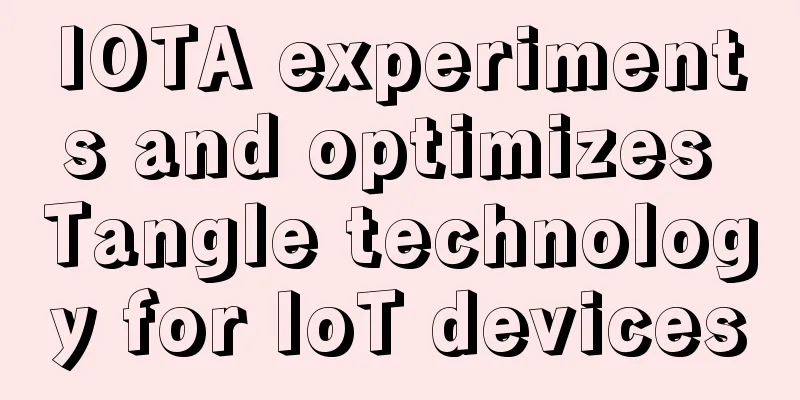IOTA experiments and optimizes Tangle technology for IoT devices

Translation: Nicole David SΦnstebΦ, founder and lead developer of IOTA, announced to the IOTA community this week a significant improvement to IOTA’s core technology. IOTA is a decentralized micro-transaction digital currency designed for the Internet of Things (IoT) system. By using a blockchain technology called 'Tangle', IOTA can efficiently handle a large number of problems that affect traditional blockchain technology. The optimized IOTA core technology can effectively change the supply of the proprietary token. These changes include removing decimal points, splitting the total amount of tokens, and increasing the total amount of tokens day by day. Removing decimal points allows coders to make fewer mistakes when calculating the number of tokens. The purpose of the token split is to eliminate the step of verifying data after each calculation, which can automatically reduce the necessary technical expenses, thereby optimizing the IOTA micro-IoT device technology. The supply of IOTA will increase from the original 999,999,999.999.999 to 2,779,530,283,277,761. SΦnstebΦ explained the reason for the supply change:
In other words, even if the total amount of split tokens increases, the proportion of tokens held by current users will not change. IOTA also provides three levels of security signatures: 128-bit, 256-bit and 384-bit, with the aim of providing optimized security and resilience for devices in the IoT ecosystem. 81-trit (128-bit) — relatively low security, but very efficient — is the best choice for micro IoT devices that store small amounts of value. 162-trit (256-bit security) — standard security, moderately effective — is the best choice for custodian wallets and devices storing large amounts of value. 243-trit (384-bit) – a fully fledged quantum-safe proven mechanism that complies with NSA specifications for sensitive material – suitable for the paranoid and for high-value transactions. The project also adds built-in message authentication capabilities, allowing third-party developers to use IOTA’s built-in mechanisms, bringing IOTA one step closer to becoming a complete IoT standard. In March, the project team conducted an experiment to allow the reuse of addresses to make it easier for people to use IOTA. However, this obviously led to more obvious problems, such as inefficient Tangle verification, so the project will return to the original address format. SΦnstebΦ revealed:
The IOTA founder revealed that the user-friendly graphical user interface will be released in the “next few days”, along with many non-technical updates to be released in the following days and weeks. In March, IOTA partnered with Hong Kong-based blockchain IoT research lab Chain of Things and will apply its technology to the Chain of Things solar case study and the London 2016 conference. |
Recommend
Abra, a Bitcoin remittance company that raised $14 million, announced that it will launch a global Bitcoin network next month, supporting more than 50 countries
Bill Barhydt, founder and CEO of the much-anticip...
ViaBTC Pool and Enegix have reached a strategic cooperation, accelerating the global layout!
On October 26, 2020, ViaBTC Pool announced a glob...
[Mining Machine Review] Unraveling the mystery, Jinbei X5 mining machine disassembly review
Written by: Jack, Layout by: Zhang Wei WeChat pub...
Luyitong acquires Bitcoin chip manufacturer for 3 billion
Author: Hey Yaoyao The price of Bitcoin has gone ...
Good luck follows these faces most likely to make a fortune
Everyone knows that if you want to make money, yo...
Women with chicken-beak ears are prone to financial loss
In real life, facial features are generally analy...
Bitcoin's on-chain transaction volume in March reached nearly $366.3 billion, a record high
According to data compiled by TheBlock Research, ...
Is it good for people to have a long love line?
In palmistry, if a person's love line is too ...
How to read the marriage line in palmistry? Which palm lines have a higher chance of divorce?
Is the marriage line in palmistry accurate? The m...
The 17 millionth Bitcoin is about to be minted. What does this mean?
According to Blockchain.info, barring unforeseen ...
Be careful, these are heartless men
When getting along with others, there will be suc...
Facial features of a person who is very smooth in dealing with others
A person's IQ and EQ can be easily seen from ...
This week, Bitcoin may face a life-or-death test
Bitcoin may face a big test this week. Bitcoin ha...
Blockchain forks
The Ethereum flag is fluttering, and DAO also has...
Faces that will lead to low luck in love
Faces that will lead to low luck in love Good luc...









